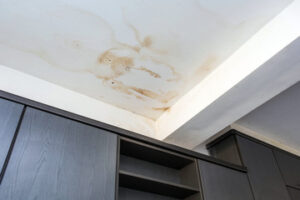Roof leaks are a major concern for homeowners, as they can cause rotting framing, mold growth, and water damage to your walls and ceilings.
Often, roof leaks can be traced back to their source. However, finding the exact spot isn’t always easy.
If you’re a home owner, you should know that one of the most common causes of roof leaks is flashing damage. This is because faulty flashing can allow water to enter through tiny cracks in your shingles or even under them.
There are a number of things that you can do to check for this type of problem. The first thing that you should do is look at your flashing, particularly around valleys or where two roofing planes meet. If you notice any cracks in your flashing, or if they’re slightly bent or cracked, you should have this area looked at right away.
Another sign that your flashing needs repair is if it’s starting to rust or corrode. This is a sign that the flashing material no longer protects your roof from water, and it will need to be replaced or cleaned up.
You may also be able to see signs of this problem if your shingles are lifted around the flashing. This indicates that the flashing is no longer protecting the shingles and the shingle deck below it from rainwater and will need to be repaired.
The best way to repair this is by filling in the small holes with roofing cement and then patching them up. Start by roughing up the area around the hole with a little bit of sandpaper to make it easier for the cement to adhere to the damaged flashing.
Once you’ve cleaned up the area, you should cut a patch that is a little larger than the hole so that it overlaps on all sides. Then, apply a generous amount of roofing cement to the patch and the flashing itself.
Depending on the severity of the problem, this can be done by yourself, or it might be better to leave the work to the professionals. A professional can ensure that the flashing is correctly installed, which helps prevent a future roof leak from occurring.
A professional should also be able to spot other issues that might indicate damaged or faulty flashing. This could include a musty smell coming from your chimney or firebox. These are signs that the caulking has broken and that the flashing no longer provides a seal against water.
Whether you have a leaky roof or plumbing, it is important to get the repairs done quickly and properly. The longer the problem goes unaddressed, the worse the damage may become.
First, you must determine where the leak is coming from. Some leaks can be easy to spot, but others can be quite tricky to identify. For example, if it is raining and your water is dripping from your ceiling but you don’t have any obvious signs of roof leaks, such as mold or discoloration, you could have a plumbing pipe that is leaking in the ceiling.
It is also important to note that a plumbing leak that is dripping from the ceiling will usually happen at a steady rate and stop when you turn off your water supply. While it can be difficult to pinpoint a plumbing leak that is dripping at a constant rate from the ceiling, you should be able to tell if it is a leaking pipe or not by the color of the water.
Another way to check for a leak is to see if it appears in the same place every time you have a heavy downpour. This will help you find out where the leak is coming from and will prevent you from wasting money on costly roofing repairs that are not needed.
If you have a leak in the same area each time it rains, you can look for stains that are several feet above the leak or to the left and right of it. If the stains are near any roof penetrations, such as vents, pipes, dormers, or chimneys, these are the most common culprits.
